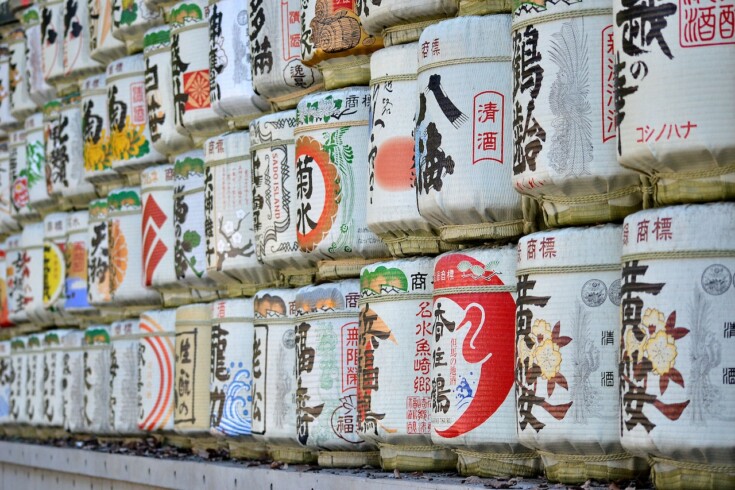
Sake is a traditional Japanese rice wine that has gained popularity worldwide. It is a versatile drink that can be enjoyed on its own or paired with different types of food. However, once you open a bottle of sake, how long can you keep it before it goes bad? Many factors can affect the shelf life of sake, such as the type of sake, storage conditions, and whether the bottle has been opened or not.
Knowing how long sake lasts after opening is essential to avoid wasting good sake or drinking bad sake. In the following sections, we will explore different types of sake, how to store sake, and how to tell if sake has gone bad.
 photo credit: i2.pickpik.com
photo credit: i2.pickpik.com
Table of Contents
Understanding Sake
Sake is a Japanese alcoholic beverage that is made from fermented rice. It is sometimes referred to as rice wine, but it is actually closer in production to beer. Sake is typically served chilled, at room temperature, or warmed, depending on the type and personal preference.
Sake is made from a combination of rice, water, yeast, and koji, which is a type of mold that helps to break down the starch in the rice into sugar. The rice used to make sake is typically a short-grain variety that has a high starch content.
There are several different types of sake, each with its own unique flavor profile and brewing process. The main types of sake include:
- Junmai: Made with only rice, water, yeast, and koji
- Honjozo: Made with rice, water, yeast, and koji, with a small amount of distilled alcohol added
- Ginjo: Made with rice that has been polished to remove more of the outer layer, resulting in a more refined and delicate flavor
- Daiginjo: Made with rice that has been polished even further than Ginjo sake, resulting in an even more refined and delicate flavor
Sake is typically served in small cups or glasses, and it is often paired with Japanese cuisine. It is important to store sake properly to ensure that it maintains its quality and flavor. Once a bottle of sake has been opened, it should be consumed within a few days to a week, depending on the type of sake and how it is stored.
Factors Affecting Sake Shelf Life
Quality of Sake
The quality of sake is an important factor in determining how long it will last after opening. High-quality sake tends to have a longer shelf life than lower-quality sake. This is because high-quality sake is made with a higher percentage of rice polishing, which removes impurities and results in a cleaner, more refined taste.
Additionally, high-quality sake is often pasteurized, which helps to extend its shelf life. Pasteurization involves heating the sake to a specific temperature for a set amount of time, which kills off any bacteria that may be present. This process helps to prevent spoilage and maintain the quality of the sake for a longer period of time.
Storage Conditions
Proper storage conditions are crucial for maintaining the quality and extending the shelf life of sake after opening. Sake should be stored in a cool, dark place, away from direct sunlight and heat sources. Exposure to light and heat can cause the sake to spoil more quickly, resulting in a shorter shelf life.
Sake should also be stored in an airtight container to prevent oxidation. Once sake is exposed to air, it begins to oxidize, which can cause the flavor to change and the sake to spoil. It is recommended to transfer the sake to a smaller container after opening to minimize the amount of air in contact with the sake.
In addition, sake should be refrigerated after opening to slow down the oxidation process and extend its shelf life. While some sake can be stored at room temperature, refrigeration is recommended for most types of sake to maintain their quality and freshness.
Opened Sake Lifespan
Once you have opened a bottle of sake, it is best to consume it within a certain period of time to ensure that it maintains its quality and flavor. The lifespan of opened sake depends on several factors, including the type of sake, the storage conditions, and whether the bottle has been opened before.
According to SakeSensei, the general rule of thumb is to refrigerate the sake and consume it within a couple of months. However, this can vary depending on the type of sake. For example, unpasteurized sake has a shorter lifespan than pasteurized sake and should be consumed within six months of opening.
It is also important to store opened sake properly to ensure that it stays fresh for as long as possible. As Sake Social suggests, it is best to keep the sake in a cool and dark place to prevent it from being exposed to light and heat, which can affect its flavor. Additionally, it is recommended to consume the sake within 12–15 months after the bottling date.
If you find that an opened bottle of sake does not taste as good as it did when it was first opened, there are a few things you can try to salvage it. Sake Social recommends warming the sake or even making it hot to bring out its flavor. However, keep in mind that this may not work for all types of sake, and it is better to consume it while it is still fresh.
Unopened Sake Lifespan
Sake is a popular Japanese alcoholic beverage that has been around for centuries. The lifespan of unopened sake depends on several factors, including the quality of the sake, how it is stored, and the manufacturing date. Here’s what you need to know about the lifespan of unopened sake.
Manufacturing Date
Sake does not have an expiration date, but it does have a manufacturing date. The manufacturing date is usually printed on the label of the bottle. Sake is best consumed within a year of the manufacturing date, but it can still be safe to drink for up to two years after the manufacturing date.
Quality of Sake
The quality of sake can also affect its lifespan. High-quality sake that is made using traditional methods can have a longer lifespan than lower-quality sake. Additionally, sake that is made using pasteurization methods can also have a longer lifespan.
Storage
Proper storage is essential to ensure that unopened sake lasts as long as possible. Sake should be stored in a cool, dark place, away from direct sunlight and heat sources. Ideally, sake should be stored at a temperature between 41°F and 68°F. Sake should also be stored upright to prevent the cork from drying out.
Unopened sake can last up to two years from the manufacturing date if it is stored properly. The quality of the sake and the manufacturing process can also affect its lifespan. It’s important to check the manufacturing date and store sake in a cool, dark place to ensure that it lasts as long as possible.
Signs of Spoiled Sake
Sake is a delicate beverage that can easily spoil if not stored and handled properly. Here are some signs to look out for to know if your sake has gone bad:
1. Unpleasant Odor
One of the first signs of spoiled sake is a sour or unpleasant odor. If your sake smells like vinegar or has a strong alcohol smell, it may have gone bad. This is because the yeast and bacteria in the sake have produced off-flavors and aromas that are not pleasant.
2. Strange Color
Sake is typically clear and colorless, but if it has gone bad, it may have a cloudy appearance or a strange color. If the sake appears yellow or brown, it may be oxidized, which can alter its taste and aroma.
3. Unpleasant Taste
Spoiled sake can have a bitter or sour taste that is not enjoyable. If your sake tastes like vinegar or has a strong alcohol taste, it may have gone bad. The taste of spoiled sake can be quite different from that of fresh sake, and it may be difficult to drink.
4. Change in Texture
Fresh sake has a smooth and silky texture, but if it has gone bad, it may have a gritty or rough texture. This is because the rice solids and sediment in the sake can settle at the bottom of the bottle and create an unpleasant texture.
Safe Consumption Practices
Once a bottle of sake is opened, it is important to consume it within a reasonable time frame to ensure its quality and safety. Here are some safe consumption practices to keep in mind:
- Refrigerate after opening: Sake should be refrigerated after opening to slow down the oxidation process and preserve its flavor and aroma. Leaving it at room temperature can cause it to spoil faster and develop off-flavors.
- Consume within a few weeks: While some sources suggest that sake can last for a few months after opening, it is generally recommended to consume it within a few weeks to ensure its freshness. The longer it sits in the bottle, the more it will deteriorate in quality.
- Check for signs of spoilage: Before consuming sake, it is important to check for any signs of spoilage, such as a sour or vinegar-like smell, cloudy appearance, or off-flavors. If it smells or tastes off, it is best to discard it.
- Avoid drinking expired sake: While sake does not have an expiration date, it is still important to avoid drinking sake that has been stored for too long or has gone bad. Drinking expired sake can cause food poisoning or other health issues.
- Store properly: To extend the shelf life of sake, it should be stored properly in a cool, dark place away from direct sunlight and heat sources. Once opened, it should be stored in the refrigerator and consumed as soon as possible.
Frequently Asked Questions
How long can you keep sake after opening?
Once opened, sake can last up to a week in the refrigerator. However, it is best to consume it within three days to enjoy its optimal flavor and freshness.
What is the shelf life of opened sake?
The shelf life of opened sake depends on various factors, such as the type of sake, the storage conditions, and the date of opening. Generally, unpasteurized sake will last for 2-4 weeks after opening, while pasteurized sake can last up to a week in the refrigerator.
How to store opened sake properly?
Sake should be stored in a cool, dark place away from direct sunlight and heat sources. Once opened, it should be stored in an airtight container or resealed using its original cap or cork. For longer storage, it is recommended to transfer the sake into a smaller bottle to minimize air exposure.
How to tell if opened sake has gone bad?
Opened sake that has gone bad may have a sour or off smell, a cloudy appearance, or a strange taste. It is best to discard sake that has gone bad.
How to extend the life of opened sake?
To extend the life of opened sake, it is recommended to store it in the refrigerator and minimize air exposure. Using a vacuum pump or inert gas can also help preserve the flavor and freshness of sake.
Conclusion
Sake can last for a considerable amount of time after opening, but it’s essential to store it properly to extend its shelf life. Sake doesn’t have an expiration date, but it does have a manufacturing date on the label. It’s recommended to consume sake as soon as possible for the best taste and aroma.
The shelf life of sake after opening depends on several factors, including the type of sake, storage conditions, and the frequency of opening and closing the bottle. Generally, unopened sake can last for several years, while opened sake can last for up to a week or two in the refrigerator.
To extend the shelf life of opened sake, it’s essential to store it in a cool, dark place, such as a refrigerator, and avoid exposure to light, heat, and air. It’s also recommended to transfer the sake to a smaller container with a tight-fitting lid to minimize the air inside the bottle.
Sake is a versatile and delicious beverage that can be enjoyed on many occasions. By following the proper storage guidelines, sake lovers can enjoy their favorite beverage for an extended period without compromising its quality and taste.
Related Posts
Here are some related posts that you might find interesting:
- There’s no “best whisky in the world”: In this post, the author talks about the hype around the best whisky in the world and how it’s all subjective.
- Those new Japanese distilleries to watch out: This post highlights some of the new Japanese distilleries that are worth keeping an eye on.
- Japanese Whisky Facts: Why is Karuizawa so hot?: This post explores why Karuizawa, a Japanese whisky distillery that closed down in 2000, is so popular among whisky enthusiasts.
- 10 Facts you may not know about Japanese Whisky: This post provides some interesting facts about Japanese whisky that you might not have known.
- Dream Dram: The Glover 22 (a Scotch & Japanese Whisky fusion): In this post, the author talks about The Glover 22, a blended malt made up of rare Japanese and Scottish whiskies.



